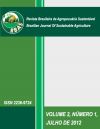CASTOR BEAN AND SUNFLOWER INTERCROPPING SYSTEMS IN ROW ARRANGEMENT: BIOLOGICAL EFFICIENCY
DOI:
https://doi.org/10.21206/rbas.v2i1.57Abstract
An experiment field was carried in the agricultural seasons 2008, 2009 and 2010, with aim of studying the response of castorbean (Ricinus communis L.) intercropping with sunflower (Helianthus annus L.) in row arrangement in the dryland farming conditions. In addition, it was evaluated the biological efficiency of plants in intercropping systems.The design used in the experiment was randomized block with seven treatement and four replications. The treatments were represented by rows of castor oil (Ma) and sunflower (Gi) listed below: 1Ma:1Gi; 1Ma:2Gi; 1Ma:3Gi; 2Ma:2Gi; 2Ma:3Gi; castor and sunflower in the monoculture. The efficiency of intercropping was measured by LER, ATER, LEC, average between LER and ATER, SPI and CoR. The grain yield of castor bean and sunflower were reduced in intercropped row arrangements. The row arrangement 1Ma:2Gi showed the smallest reduction of average productivity of castor beans and sunflower in the evaluation period of the experiment. The castor bean was the dominant crop in relation to sunflower.Downloads
Download data is not yet available.
Downloads
Published
2012-07-01
How to Cite
Ciro de Miranda Pinto, Olienaide Ribeiro de Oliveira Pinto, & João Bosco Pitombeira. (2012). CASTOR BEAN AND SUNFLOWER INTERCROPPING SYSTEMS IN ROW ARRANGEMENT: BIOLOGICAL EFFICIENCY. Brazilian Journal of Sustainable Agriculture, 2(1). https://doi.org/10.21206/rbas.v2i1.57
Issue
Section
Artigos
License
1. Proposta de Política para Periódicos de Acesso Livre
Autores que publicam nesta revista concordam com os seguintes termos:
Autores mantém os direitos autorais e concedem à revista o direito de primeira publicação, com o trabalho simultaneamente licenciado sob a Licença Creative Commons Attribution que permite o compartilhamento do trabalho com reconhecimento da autoria e publicação inicial nesta revista.












